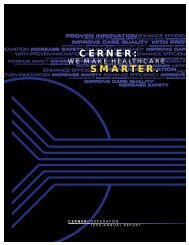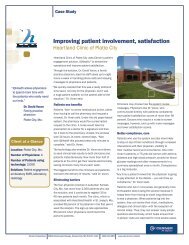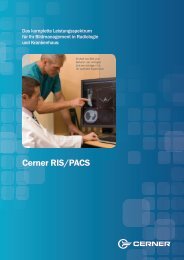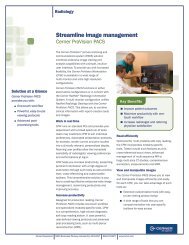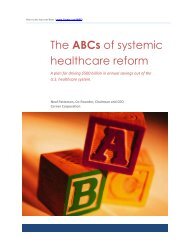The ABCs of systemic healthcare reform - Cerner Corporation
The ABCs of systemic healthcare reform - Cerner Corporation
The ABCs of systemic healthcare reform - Cerner Corporation
- No tags were found...
Create successful ePaper yourself
Turn your PDF publications into a flip-book with our unique Google optimized e-Paper software.
All <strong>of</strong> the auction rate securities that the Company currently holds are A rated or higher and are collateralized by student loan<br />
portfolios, the majority <strong>of</strong> which are backed by the U.S. government through its Federal Family Education Loan Program.<br />
Management regularly reviews investment securities for impairment based on both quantitative and qualitative criteria that<br />
include the extent to which cost exceeds fair value, the duration <strong>of</strong> the market decline, our intent and ability to hold to maturity<br />
or until forecasted recovery, and the financial health <strong>of</strong> and specific prospects for the issuer. Unrealized losses that are other<br />
than temporary are recognized in earnings. We do not believe the auction failures will materially impact our ability to fund our<br />
working capital needs, capital expenditures or other business requirements.<br />
(8) Interest Income (Expense)<br />
A summary <strong>of</strong> interest income and expense is as follows:<br />
(9) Stock Options and Equity<br />
At the end <strong>of</strong> 2008 and 2007, the Company had 1,000,000 shares <strong>of</strong> authorized but unissued preferred stock, $.01 par value.<br />
As <strong>of</strong> January 3, 2009, the Company had four fixed stock option and equity plans in effect for associates. <strong>The</strong> awards granted<br />
under these plans qualify for equity classification pursuant to SFAS 123R. Amounts recognized in the consolidated financial<br />
statements with respect to these plans are as follows:<br />
During 2008, the Company had two shareholder approved long-term incentive plans from which it could issue grants.<br />
Under the 2001 Long-Term Incentive Plan F, the Company is authorized to grant to associates, directors and consultants<br />
4,000,000 shares <strong>of</strong> common stock awards taking into account the stock-split effective January 10, 2006. Awards under this<br />
plan may consist <strong>of</strong> stock options, restricted stock and performance shares, as well as other awards such as stock appreciation<br />
rights, phantom stock and performance unit awards which may be payable in the form <strong>of</strong> common stock or cash at the<br />
Company’s discretion. However, not more than 1,000,000 <strong>of</strong> such shares will be available for granting any types <strong>of</strong> grants other<br />
than options or stock appreciation rights. Options under Plan F are exercisable at a price not less than fair market value on the<br />
date <strong>of</strong> grant as determined by the Stock Option Committee. Options under this plan typically vest over a period <strong>of</strong> five years as<br />
determined by the Stock Option Committee and are exercisable for periods <strong>of</strong> up to 25 years.<br />
Under the 2004 Long-Term Incentive Plan G, the Company is authorized to grant to associates and directors 4,000,000 shares<br />
<strong>of</strong> common stock awards taking into account the stock-split effective January 10, 2006. Awards under this plan may consist <strong>of</strong><br />
stock options, restricted stock and performance shares, as well as other awards such as stock appreciation rights, phantom<br />
stock and performance unit awards which may be payable in the form <strong>of</strong> common stock or cash at the Company’s discretion.<br />
Options under Plan G are exercisable at a price not less than fair market value on the date <strong>of</strong> grant as determined by the Stock<br />
Option Committee. Options under this plan typically vest over a period <strong>of</strong> five years as determined by the Stock Option<br />
Committee and are exercisable for periods <strong>of</strong> up to 12 years. In 2007, Long-Term Incentive Plan G was amended to provide the<br />
Company the ability to recover fringe benefit tax payments made by the Company on behalf <strong>of</strong> its associates in India.<br />
<strong>The</strong> fair market value <strong>of</strong> each stock option award is estimated on the date <strong>of</strong> grant using a lattice option-pricing model. In 2006,<br />
the Company changed its valuation model from the Black-Scholes option-pricing model to the lattice pricing model because it is<br />
believed to provide greater flexibility for valuing the substantive characteristics <strong>of</strong> employee share instruments, resulting in a<br />
more accurate estimate <strong>of</strong> fair market value. <strong>The</strong> pricing model requires the use <strong>of</strong> the following estimates and assumptions:<br />
• Expected volatilities under the lattice model are based on an equal weighting <strong>of</strong> implied volatilities from traded options<br />
on the Company’s shares and historical volatility. <strong>The</strong> Company uses historical data to estimate the stock option<br />
76



